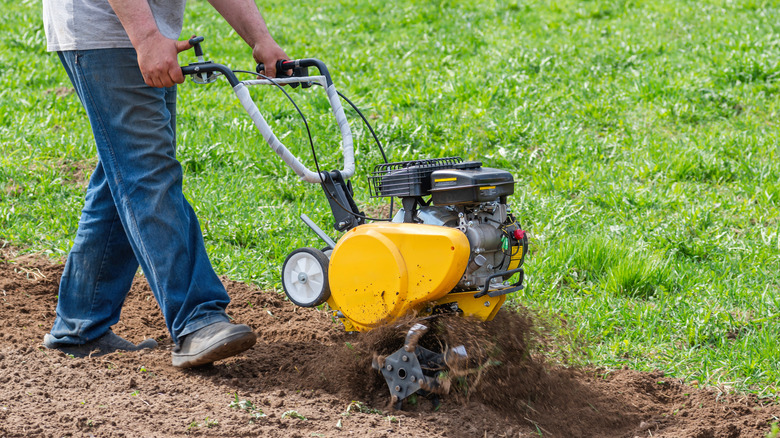8 Best Ways To Get Rid Of Tomato Worms
Tomatoes are one of the easiest plants to grow in your garden. There are several varieties, but whichever you choose to go with, you can generally count on a decent harvest if you give them proper light and nutrients, according to the University of New Hampshire. Additionally, while tomato plants suffer from their fair share of nutritional deficiencies and diseases, nothing quite compares to the damage that destructive green hornworm can inflict.
Green hornworms are the larvae of the Sphinx moth. They are a brilliant shade of green that almost matches the color of the plant, which makes them difficult to spot. These pests also have white "v-shaped" spots on their bodies and a sharp horn on their tails. The female moth lays its eggs on tomato plant stems and leaves where they hatch. The caterpillars are tiny when they begin eating the plants but can grow remarkably fast. In just a few days, they can eat all the leaves on a single plant. Hornworms can be difficult to remove, but there are some methods that prove to be successful (via The Old Farmer's Almanac).
1. Remove tomato worm by hand
Removing tomato hornworms from plants by hand is one way — if not the best way — to get rid of them. That being said, it takes patience and time to regularly check plants. The best way to locate hornworms is to look under the leaves of eaten or missing leaves (per Grow Veg). When you see one, pull it off the plant. The Old Farmer's Almanac notes that these worms are not harmful to humans and they do not bite, so it is safe to take them off plants. You can step on them or drop them in a bucket of soapy water.
2. Till your garden soil
If you do not kill the hornworms on your tomato plants, they will eventually fall off the plants and into your garden soil where they stay throughout the winter. They reemerge in the spring as adult moths, and the females will eventually lay eggs on your tomato plants and repeat the cycle, notes the University of Minnesota. One way to prevent the larvae from surviving the winter is to till the soil before planting in the spring. The Old Farmer's Almanac notes that tilling at this time of year destroys up to 90% of the larvae. The University of Minnesota also suggests tilling after harvest in the fall to destroy any larvae and remaining caterpillars.
3. Attract predatory insects
When it comes to tomato hornworms, some predatory insects can be your friends. Green lacewings feed on the small larvae of the worms, and you can attract them by adding rocks, stones, or boards to your garden, according to The Denver Post. Lady beetles also feed on larvae and you can encourage them to visit your garden by planting dill, coriander, cilantro, and thyme. Female parasitic wasps lay their eggs on the worms, which eventually hatch and eat the worms. You can attract these wasps with zinnias, fennel, dill, cosmos, and thyme.
4. Invite other critters who prey on tomato worms
Some birds enjoy feasting on tomato hornworms, so keep a birdbath and bird feeders near your garden to encourage frequent visits. If you can grow your tomatoes by a few trees, you also increase the chances that birds will stay nearby. SF Gate notes that flower pots placed bottom-side up with one side propped open with a small rock or stick make perfect homes for toads, who also like to eat the worms.
5. Grow companion plants
You can also grow what are called "companion plants" to deter tomato hornworms from making a home in your garden. SF Gate suggests planting marigolds and borage in or next to your garden to fend off hornworms. Borage has an added advantage because it enriches the soil with calcium, potassium, and other minerals. The Gardening Channel recommends planting "sacrificial" dill plants among your tomato plants because hornworms prefer dill over tomatoes. You can still remove the worms from the dill and perhaps save those plants, but with any luck, they won't migrate to your tomato plants.
6. Try a hot pepper mixture
Hot peppers and garlic make a nice tomato hornworm deterrent for relatively cheap. For this easy homemade recipe, place four or more hot peppers, such as cayenne or habanero, 2 to 4 cloves of garlic, 2 tablespoons of olive oil, and 1 tablespoon of unscented liquid soap in a blender. Blend on high until everything is well combined, then place the solution in a bowl and allow it to sit for 12 hours to bring out the flavor of the garlic and peppers. Strain the mixture and add 2 tablespoons of it with 16 ounces of water into a spray bottle. Spray all parts of the plant with the solution as often as desired, per Hunker.
7. Use neem oil
Neem oil is a natural insect repellent you can use to try to keep hornworms at bay. Mix ¼ teaspoon of liquid soap and 1 teaspoon Neem oil with 1 quart of water in a spray bottle. Shake well and spray the mixture to all parts of the plant. Use every seven days and reapply after rain. Just like with a garlic and pepper solution, Hunker recommends you should always clean your tomatoes thoroughly after harvesting them to ensure all of the solution is washed away.
8. Use insecticides with caution
If you have several tomato plants or a large garden, you may find that trying to manage hornworms is simply too difficult. Insecticides are an option, but The Old Farmer's Almanac notes that this should always be a last resort. Bacillus thuringiensis is an organic pesticide that is not harmful to plants or other helpful insects, but the worms must ingest it for it to be effective. Check with your state's cooperative extension for any other safe insecticides to use.








